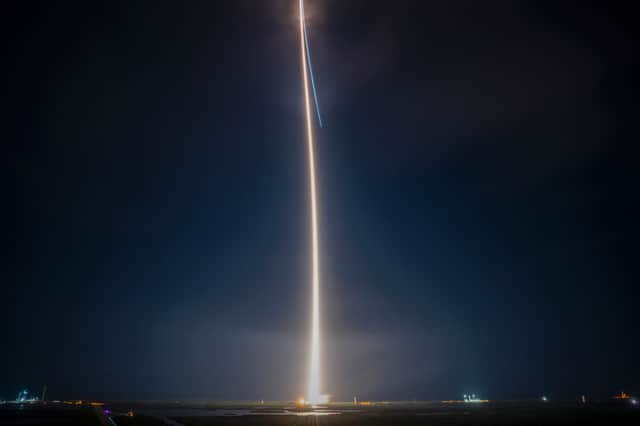Vulcan rocket launch: Peregrine Mission One moon lander explained, NASA - when was last Apollo landing?


The first US Moon mission since Apollo has launched into space with a piece of technology created by UK scientists onboard.
The US space corporation Astrobotic built the Peregrine Mission One (PM1) lander, which is set to become the first private spacecraft to lay foot on the moon.
Advertisement
Hide AdAdvertisement
Hide AdThe Vulcan rocket carrying Peregrine blasted off from Cape Canaveral in Florida at 7.18am GMT. Now flying solo, the craft is headed for the Moon, where it will make an attempt at landing next month. Here is everything you need to know about it.
What is Peregrine's mission?
The US has not made an attempt to softly land a spacecraft on the moon since the Apollo programme ended in 1972, though in the interim, US probes have been purposefully crashed into the moon for various reasons.
NASA has put lunar surface operations back on the schedule because it hopes to resume manned trips in the near future. The agency plans to lower costs by deploying commercial robots to deliver supplies, equipment and research apparatus to the Moon.
Peregrine is carrying a total of 20 payloads from seven countries and 16 commercial customers. They include the first lunar surface payloads from the Mexican and German space agencies, and the first lunar payloads from the UK, Hungary and Seychelles.
Advertisement
Hide AdAdvertisement
Hide AdThe majority of these payloads are focused on getting ready for future human habitation on the moon, but among them are a few items which add a touch of human creativity to space exploration, including a time capsule, a bitcoin and even a music album.
Astrobotic chief executive John Thornton said: “Today Peregrine Mission One achieved a number of big milestones.Peregrine powered on, acquired a signal with Earth, and is now moving through space on its way to the Moon.
“These successes bring us one step closer to seven nations landing on the Moon, six of which have never been to the Moon before.”
Libby Jackson, head of space exploration at the UK Space Agency, said: “The Peregrine Lunar Lander will help pave the way for further exploration of our solar system."
When will Peregrine reach the Moon?
Advertisement
Hide AdAdvertisement
Hide AdPeregrine will attempt to land on the Moon on Friday 23 February. If successful, it could become the first commercial lander, and first American lander in more than 50 years, to land on the Moon.
What is the UK's involvement?
Onboard Peregrine is an instrument known as the Peregrine Ion Trap Mass Spectrometer (PITMS), which was developed in the UK by scientists from The Open University (OU) and the Science and Technology Facilities Council (STFC) RAL Space – the UK’s national space lab – in collaboration with Nasa’s Goddard Space Flight Centre in Washington DC.
A key component of PITMS, which will explore the Moon’s atmosphere by measuring water and other molecules, was developed in the UK with £14m of Government funding through the UK’s membership of the European Space Agency.
The data collected will contribute to our understanding of the Moon’s potential to provide resources such as water, opening new possibilities for future human presence on the lunar surface.
Advertisement
Hide AdAdvertisement
Hide AdThe UK-built component – called the Exospheric Mass Spectrometer represents the first instrument on the Moon that has been built in the UK and in Europe. As part of the PITMS, the Exospheric Mass Spectrometer allows researchers to study atoms and molecules in a gas.
Science and Technology Secretary Michelle Donelan said: “The Exospheric Mass Spectrometer will be the first science component developed in the UK destined for the lunar surface, marking a historic moment for the UK space industry.
“This significant achievement also lays the groundwork for understanding how to sustain extended human presence on the Moon in the future – changing the way humankind interacts with the solar system around us forever.”
Why is the mission controversial?
Among the lander's payload is a contentious shipment of cremated human remains. Two businesses have small "memorial" capsules onboard, one of which holds the DNA of well-known British science fiction author Arthur C. Clarke.
The indigenous people of the Navajo Nation in North America, who revere the moon as sacred, have urged NASA to halt the mission, which they see as an act of desecration.
Comment Guidelines
National World encourages reader discussion on our stories. User feedback, insights and back-and-forth exchanges add a rich layer of context to reporting. Please review our Community Guidelines before commenting.
